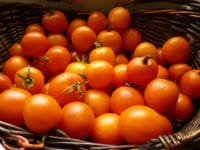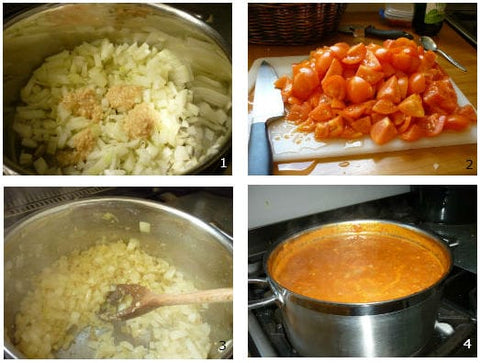It's Harvest Time!

Harvesting watermelons
Not really a fruit that can be preserved but definitely worth a mention. There are 3 ways to pick the right time to harvest:
1. The tendril nearest the point on the vine where fruit stem is attached is browning off or dead.
2. The spot where the fruit rests on the ground is yellow.
3. Tap or knock lightly on the fruit and listen for a 'pink' or 'pank' sound. When you hear the 'punk' sound, then the fruit is ripe and ready to harvest.
The Tomato Harvest
The main tomato I grew this year was the new Jaune Flamme - an heirloom ripening to a lovely bright orange which tastes great. The few plants I grew produced bountiful crops of beautiful, unblemished fruit. When giving these away I found that many of us expect our tomatoes to be red. It took me a while to interpret the strange look I was receiving. It turned out most of the recipients thought I was giving them half ripened tomatoes but, after the inevitable tasting session, all were happy to use them. To all tomato fanatics out there a challenge......... Our mission is to convince more people that those pink, yellow, black and even green tomatoes can be just as tasty!

I had been trying to decide what to do with my tomato crop. One night I had a whole bowl that needed to be used so I made a tomato pasta sauce. Being orange, I was a little wary that the sauce might be a brown sludge, but the orange colour was retained making it very pleasing to the eye when served up. With that test passed, I decided I could preserve a few for my pasta meals in the winter.
One option is just to throw your tomatoes in a plastic bag or container and freeze them in quantities you need for your sauce. Having the freezer space available is always the decision point for me, so I decided to make the sauce and then freeze it in large blocks for easy stacking. This is the recipe I used, simple, no-fuss and therefore quick to prepare. Adjust for taste to suit your family.

Tomatoes (ice-cream container full), chopped
2 large onions, chopped
garlic, 3 cloves minced or chopped finely
olive oil
1 cup chicken or vegetable stock
basil, a couple of big handfuls
1. Cook onions & garlic in olive oil until onion is just starting to brown.
2. Add chopped tomatoes and cook until just starting to turn mushy.
3. Add stock and half the basil and cook for at least 20 mins.
4. When ready to use, add other half of basil and salt and cracked pepper to taste.
Add whatever you like to this sauce (olives, other herbs, bacon, chicken, meatballs, chilli, capsicum, etc) and serve with your pasta. It keeps in the fridge for up to a week.
If you want to freeze it for later use, put it back in the ice-cream container, label and put in your freezer.
Preserving
There's nothing nicer than admiring a cupboard or shelf that contains jars and jars of preserves. Golden Queen peaches seemed to be quite plentiful and these are the ones that I remember helping Mum with. All us kids had to help with the peeling and, because I was the eldest, I was allowed the sharp knife to cut them into wedges, ready for Mum to do her magic. All so we could have peaches on our breakfast or pudding. It was quite a production line and usually required a bath or hose off to rid ourselves of peach fuzz and sticky juice. We were also full to the brim with fresh peach slices consumed while working.
I also remember jars of beetroot, spaghetti and tomato sauce, pears, apple sauce, gherkins and of course, all the different flavoured jams.
Pickles
Have you grown gherkins or pickling onions this season? I have heard that it hasn't been a great season for gherkins so they have been hard to source, if like me, you only have room in your garden for your standard cucumbers. So bread and butter pickles are a great idea to use up all those cucumbers you have.
Have you tried pickled vegetables? It's a great way to create colourful jars of cauliflower, carrots, small onions, capsicum, etc.The vegetables remain nice and crunchy and are perfect on a platter or in bean or corn salads.
Relish/Chutney
So what's the difference between a relish and a chutney? Most references point to chutney being of a spreadable consistency like jam. Relish tends to be chunkier due to being cooked less and, therefore, crunchy to the bite. Relish also tends to have little or no sugar.
Here's a basic Relish recipe and some variations to follow. This makes about 4 x 250g jars.
Ingredients:
1 cup white vinegar
1/4 cup white sugar
2 tsp salt
2 cups of your vegetable or fruit
1/2 large red & green capsicum, diced
1 stalk of celery, diced
1/2 an onion, finely chopped
2 tsp minced garlic
2 tsp dry ground mustard seed
1/2 tsp celery seeds
1/2 tsp ground tumeric
Method:
1. Sterilise the jars, have them in the oven keeping them hot at 150-160°C.
2. Combine vinegar, sugar and salt in pot and boil until dissolved.
3. Add the vegetables or fruit and all other ingredients.
4. Reduce heat and simmer for 30 mins, stirring regularly.
5. Pour hot relish into hot jars.
6. Gently bang jars on a tea towel on the bench to remove air bubbles.
7. To ensure a good seal, clean jar rims and apply hot lids to each jar.
8. Set aside to cool completely and let seals form.
Variations:
- Apple - cooking apples, juice and grated rind of 2 lemons.
- Hot Indian - cooking apples, 2 tsp ground ginger, 3 tsp mustard powder, 2 tsp paprika, 1 tsp ground coriander.
- Pear - pears, demerara sugar, 1/4 tsp cayenne pepper, 1/2 tsp grated nutmeg.
- Peach - peaches, demerara sugar, 1 piece root ginger (peeled & grated), juice & grated rind of a lemon.
- Zucchini/Courgette - chopped zucchini, ground allspice.
- Corn - fresh corn kernels, dry mustard powder, cider vinegar.
We would love to hear about anything unusual you are preserving. Please share your story!

























































